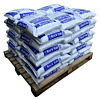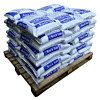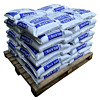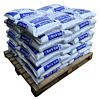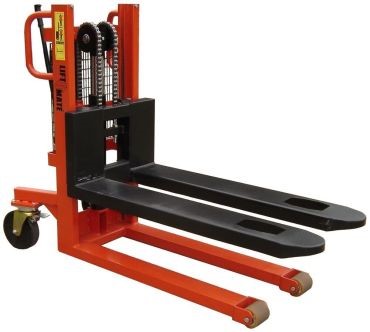
Understanding the True Economics of Material Handling Equipment Selection
When equipping a warehouse or production facility with material handling equipment, the choice between electric and manual stackers represents a significant decision with long-term operational and financial implications. While the initial purchase price often receives the most attention, the cost of electric vs manual stackers extends far beyond the acquisition price, encompassing operational expenses, productivity factors, maintenance requirements, and workforce considerations that impact the total cost of ownership over the equipment's service life.
Making an informed decision requires a comprehensive analysis of both the obvious and hidden costs associated with each option. This guide explores the complete economic picture of manual and electric stackers to help you determine which solution delivers the best return on investment for your specific operational needs.
Initial Investment Comparison
The most apparent difference between manual and electric options is the acquisition cost:
Manual Stacker Purchase Expenses
Manual units typically involve more straightforward initial investments:
- Purchase price range: $1,000-$3,500 for standard models
- Basic models: Starting around $1,000-$1,500 for 2,200 lb (1,000 kg) capacity
- Heavy-duty versions: $2,500-$3,500 for capacities up to 3,300 lbs (1,500 kg)
- Specialized options: Additional $500-$1,000 for features like adjustable forks or straddle legs
- Delivery and setup: Minimal costs due to simpler assembly requirements
The simplicity of manual systems results in significantly lower upfront expenses.
Electric Stacker Acquisition Costs
Electric units represent a more substantial initial investment:
- Purchase price range: $3,500-$12,000+ depending on capacity and features
- Entry-level models: Starting around $3,500-$5,000 for basic functionality
- Standard configurations: $5,000-$8,000 for mid-range capacities and features
- Advanced models: $8,000-$12,000+ for higher capacities and specialized functions
- Batteries and chargers: Sometimes separate expenses adding $1,000-$2,500
- Delivery and commissioning: Higher costs due to more complex setup requirements
This substantial price differential often drives decision-makers toward manual options when considering only initial expenses.
Operational Cost Factors
Daily operating expenses reveal significant differences between the options:
Manual Stacker Operating Expenses
Human-powered operation creates unique cost considerations:
- Labor intensity: Requires significant physical effort from operators
- Reduced productivity: Slower operation speeds and increased operator fatigue
- Operator limitations: Possible restrictions on who can safely operate the equipment
- Fatigue factors: Decreased efficiency over the course of shifts
- Injury potential: Possible workers' compensation and lost time costs
- Zero energy costs: No electricity or battery expenses
These operational factors can significantly impact the true cost despite the absence of energy expenses.
Electric Stacker Operating Expenses
Powered operation introduces different cost elements:
- Energy consumption: Typically $0.75-$1.50 per charging cycle
- Battery maintenance: Periodic water checking and addition for lead-acid batteries
- Charging infrastructure: Dedicated electrical outlets or charging stations
- Battery replacement: Every 3-5 years at $1,000-$2,500 depending on type
- Higher productivity: More loads moved per hour offsetting operational costs
- Broader operator capability: More staff can operate with less physical strain
While introducing energy and battery expenses, these costs are often offset by significant productivity advantages.
Productivity and Efficiency Analysis
The economic impact of equipment productivity significantly influences total cost:
Manual Stacker Productivity Metrics
Human-powered operation creates inherent limitations:
- Lifting speed: Approximately 20-30 seconds per standard lift cycle
- Movement efficiency: Slower travel speeds, especially with loaded unit
- Operator endurance: Decreasing performance over work shifts
- Rest requirements: Necessary breaks during continuous operation
- Weight limitations: Typical maximum capacity of 2,200-3,300 lbs (1,000-1,500 kg)
- Height restrictions: Usually limited to 10-12 feet (3-3.7 meters) maximum
These limitations impact the volume of work completed per hour and per shift.
Electric Stacker Productivity Advantages
Powered operation delivers substantial efficiency benefits:
- Lifting speed: Approximately 5-10 seconds per standard lift cycle
- Consistent performance: Maintaining speed throughout shifts
- Higher capacities: Typically 2,200-4,400+ lbs (1,000-2,000+ kg)
- Greater lift heights: Often reaching 12-18+ feet (3.7-5.5+ meters)
- Reduced operator fatigue: Maintaining productivity across entire shifts
- Faster travel speeds: Quicker movement between operational areas
These productivity advantages often translate to handling 2-3 times more loads per hour compared to manual alternatives.
Labor Cost Implications
The relationship between equipment choice and labour expenses is significant:
Manual Stacker Labor Considerations
Human-powered equipment creates several labour-related expenses:
- Physical requirements: Limiting the available operator pool
- Potential for injury: Increasing workers' compensation claims
- Fatigue factors: Reducing productivity over shift duration
- Training simplicity: Requiring less technical instruction
- Operator turnover: Potentially higher due to physical demands
- Supplemental labour needs: Additional workers to maintain throughput
These factors can substantially impact overall operational costs.
Electric Stacker Workforce Advantages
Powered equipment offers several labour-related benefits:
- Broader operator demographics: More employees capable of safe operation
- Reduced injury risk: Decreasing lost time and compensation claims
- Consistent productivity: Maintaining performance throughout shifts
- Technical training requirements: More comprehensive initial instruction
- Single-operator efficiency: Accomplishing tasks that might require multiple staff with manual equipment
- Employee satisfaction: Improved working conditions and reduced physical strain
These advantages often result in more efficient labour utilization despite higher initial training requirements.
Maintenance and Service Expenses
Equipment upkeep represents a significant component of lifecycle costs:
Manual Stacker Maintenance Profile
Simpler mechanical systems typically result in lower maintenance needs:
- Annual maintenance cost: Approximately 5-10% of purchase price
- Common service needs: Hydraulic system maintenance, wheel replacement
- Repair simplicity: Often serviceable by in-house maintenance staff
- Parts costs: Generally lower due to simpler components
- Service frequency: Typically 1-2 preventive maintenance visits annually
- Downtime impacts: Often less critical due to lower throughput dependency
The mechanical simplicity of manual systems typically results in lower maintenance expenses.
Electric Stacker Service Requirements
More complex systems introduce additional maintenance considerations:
- Annual maintenance cost: Approximately 10-15% of purchase price
- System complexity: Electrical, electronic, hydraulic, and mechanical components
- Specialized service needs: Often requiring trained technicians
- Critical components: Motors, controllers, batteries, and chargers
- Preventive maintenance: Typically 2-4 scheduled services annually
- Downtime significance: Potentially greater operational impact due to throughput dependency
These more sophisticated systems generally require more extensive and costly maintenance programs.
Lifespan and Depreciation Factors
Equipment longevity significantly impacts the annual cost of ownership:
Manual Stacker Lifecycle Expectations
Simpler systems often offer different service life characteristics:
- Typical service life: 5-8 years under normal usage
- Usage limitations: Generally designed for lower volume applications
- Depreciation rate: Usually straight-line over 5 years
- End-of-life value: Minimal residual value, typically less than 10% of purchase price
- Replacement triggers: Usually mechanical failure or hydraulic system issues
- Lifespan variables: Highly dependent on usage intensity and maintenance quality
These lifecycle expectations influence the annualized cost of ownership.
Electric Stacker Longevity Considerations
More robust construction often results in different lifecycle patterns:
- Typical service life: 7-10+ years for well-maintained units
- Higher usage capacity: Designed for more intensive operational demands
- Depreciation rate: Usually straight-line over 7 years
- End-of-life value: Typically 10-15% of purchase price if well-maintained
- Component replacement: Often extends useful life through updating key systems
- Battery cycles: Typically 1,000-1,500 charge cycles before replacement needed
These extended service life expectations help offset higher initial acquisition costs.
Space and Infrastructure Requirements
Facility accommodations represent another cost consideration:
Manual Stacker Facility Needs
Simpler equipment typically has minimal facility requirements:
- Storage space: Compact footprint when not in use
- Floor loading: Generally lighter weight with less structural demand
- Infrastructure requirements: No electrical charging stations needed
- Ventilation considerations: No battery charging emissions to address
- Noise factors: Quieter operation without motors
- Operational space: May require more manoeuvring room due to manual positioning
These minimal facility demands can represent a significant advantage in constrained spaces.
Electric Stacker Infrastructure Considerations
Powered equipment introduces several facility requirements:
- Charging stations: Dedicated electrical supply for battery charging
- Floor loading: Heavier equipment weight due to batteries and components
- Ventilation needs: Battery charging may require specific air exchange (for lead-acid)
- Space allocation: Battery changing/charging areas in high-usage operations
- Electrical capacity: Possible upgrades to support charging infrastructure
- Noise management: Motor and hydraulic system sounds during operation
These infrastructure requirements represent additional implementation costs that should be factored into the total investment analysis.
Application-Specific Cost Analysis
Different operational scenarios can dramatically affect the cost of electric vs manual stackers:
Light Occasional Use Scenarios
Operations with minimal stacker utilization typically find:
- Manual advantage: Lower acquisition costs not offset by productivity gains
- Utilization threshold: Electric typically not cost-justified for usage under 1-2 hours daily
- Simple task focus: Basic lifting and occasional movements favour simpler equipment
- Supplemental role: Equipment serving as backup to primary material handling systems
- Budget constraints: Limited capital expense budgets favouring lower initial investment
In these limited-use cases, manual stackers often represent the more economical total solution.
Medium-Duty Mixed Applications
Balanced operational needs present more complex economic considerations:
- Breakeven analysis: Productivity gains begin offsetting higher electric costs
- Versatility requirements: Various tasks benefiting from different equipment features
- Multi-shift operation: Extended daily usage improving electric ROI
- Mixed load profiles: Varying weights and sizes requiring adaptable equipment
- Growth trajectory: Anticipated volume increases favouring scalable solutions
These balanced applications require the most careful analysis to determine optimal investment.
High-Volume Intensive Operations
Demanding environments typically demonstrate clear economic patterns:
- Electric advantage: Productivity gains substantially offsetting higher initial costs
- Throughput requirements: Volume demands requiring powered efficiency
- Continuous operation: Extended usage patterns maximizing productivity differences
- Multi-shift utilization: Equipment used across multiple work periods daily
- Critical process role: Material handling directly impacting overall operational capacity
In these high-intensity applications, electric stackers almost invariably deliver superior economic value despite higher acquisition costs.
Total Cost of Ownership Calculation
Making an informed decision requires comprehensive financial analysis:
Five-Year Manual Stacker Cost Model
A typical medium-duty manual stacker's costs include:
- Initial purchase: £2,000 average for standard unit
- Annual maintenance: £150-£200 per year
- Productivity limitation: Approximately 20-25 load movements per hour
- Operator efficiency impact: £3,000-£5,000 annually in reduced throughput
- Lifespan expectation: Replacement likely at 5-7 years
- Total 5-year cost: Approximately £17,000-£27,000 including purchase, maintenance, and labour efficiency factors
This calculation reveals the significant hidden costs beyond the initial purchase price.
Five-Year Electric Stacker Cost Model
A comparable electric stacker's costs include:
- Initial purchase: £6,000 average for standard unit
- Energy consumption: £300-£500 annually
- Maintenance expenses: £500-£750 annually
- Battery replacement: £1,500 (once during 5-year period)
- Productivity advantage: 50-60 load movements per hour
- Total 5-year cost: Approximately £11,500-£13,750 including purchase, energy, maintenance, and battery replacement
When factoring productivity advantages, the electric option often delivers lower total ownership costs despite higher initial investment.
Making the Right Investment Decision
Determining which option delivers the best economic value requires careful assessment:
Key Decision Factors
Consider these critical elements when evaluating the cost of electric vs manual stackers:
- Usage frequency: Hours of operation per day/week
- Application intensity: Typical loads and handling requirements
- Labor costs: Prevailing wages and workforce availability
- Growth projections: Anticipated changes in operational volume
- Facility constraints: Space, infrastructure, and environmental factors
- Capital availability: Budget realities and financing options
- Operational criticality: Impact of equipment on overall throughput
These factors collectively determine which solution delivers superior economic value for your specific scenario.
Hybrid Approach Considerations
Some operations benefit from a mixed equipment strategy:
- Task-specific allocation: Electric for high-volume routes, manual for occasional tasks
- Staged implementation: Starting with manual and transitioning to electric as volumes increase
- Operational zoning: Different equipment types assigned to specific facility areas
- Peak period management: Supplemental equipment for high-demand periods
- Risk mitigation: Backup manual units supporting primary electric equipment
This balanced approach often maximizes overall economic efficiency across varying operational needs.
Expert Guidance for Material Handling Investment Decisions
Evaluating the true cost of electric vs manual stackers requires balancing numerous factors specific to your operation. At Hall-Fast, we specialize in helping customers identify the most cost-effective material handling solutions for their unique requirements.
Our comprehensive selection includes both manual and electric stackers in various configurations and price points. Our product specialists can help you analyse your specific usage patterns, calculate realistic total cost of ownership projections, and identify the equipment solution that delivers optimal economic value for your operation.
Explore our full range of material handling solutions at Hall-Fast Industrial and Commercial Equipment or contact our experts directly at sales@hall-fast.com for personalized assistance in resolving the cost of electric vs manual stackers question for your specific application.
With the right equipment matched to your operational needs and usage patterns, you'll maximize productivity while optimizing your material handling investment for years to come.



